Walkin’ In A Winter Waspy Land: The Abandoned Real Estate Of Bald-Faced Hornets
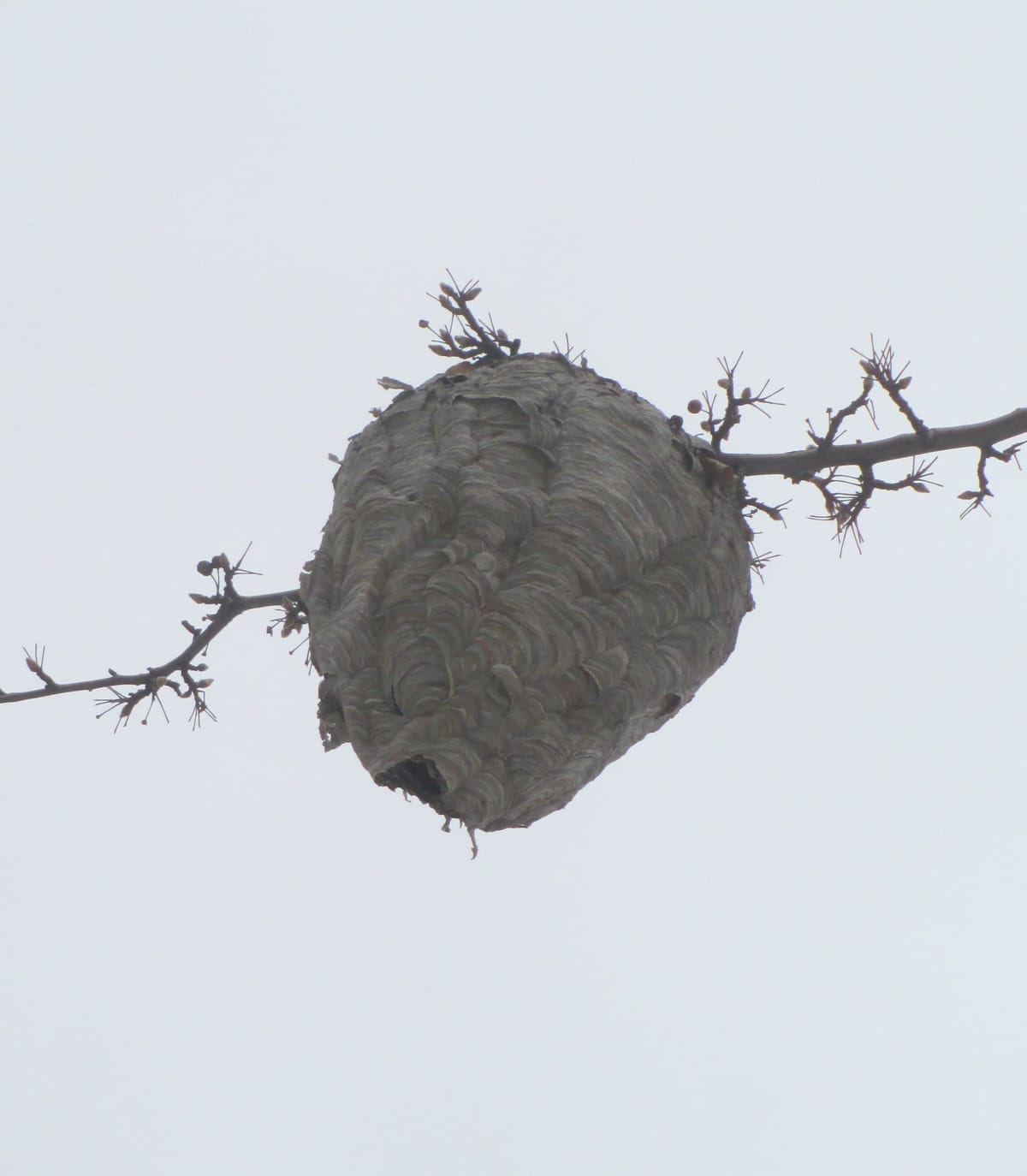
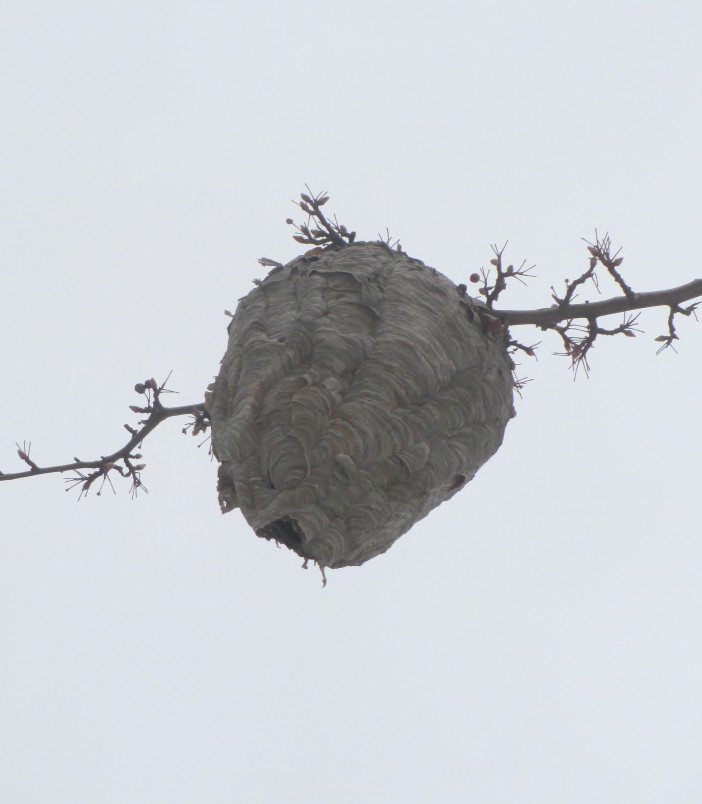
Neighbor Kristine Scheiner (who you may remember from her fantastic post about cicadas) recently went on a bald-faced hornets’ nest safari in our neighborhood, walking from around Beverley and East 18th Street to Brooklyn College to investigate what she discovered is an extraordinary abundance of the insects’ now-empty homes. These are her observations about glimpsing a world that, thanks to being shaded by branches and, well, the hornets themselves, is so often closed off to us:
The other day I was sitting around all sad and despondent, missing the Ditmas flora and fauna and mentally whining about how much more winter we still had to go through. But, on the way back from the grocery store, a miracle happened: right in the middle of feeling all sorry for myself, I was reminded that I’d been overlooking one of the coolest things that winter can offer a dingbat like myself.
As I neared home with my bag of provisions, I noticed a head-shaped object up in the tree near my apartment. It was a perfectly preserved wasps’ nest, hanging low enough that I might touch it if I had a chair to stand on! Oh, joy! How cool is that?! I was immediately hypnotized and drawn toward it in an entomological trance, marveling at its swirly details and intricately scalloped layers, until the sudden wind of a passing vehicle reminded me that I was standing in the road.
Eeeeeeeee! squealed the goblin that lives in the stuff-making part of my brain, jumping up and down and clapping excitedly. Think of all the art you can make if you can get it down!
I ran upstairs—well, elevatored up—to find my sister in the kitchen and relayed my intent to capture this prize and bring it inside.
She looked at me as if I’d lost my mind. “The hell you are!” she said in disgusted outrage. “Don’t you remember what happened in The Shining?!”
Well, yeah, I did… But I didn’t think that it could really happen… or could it? Could a wasps’ nest really thaw out and release a swarm like in Stephen King’s book? Well, my inquiring mind wanted to know and said “bee in my bonnet” (yeah, I said it…) needed satisfying.
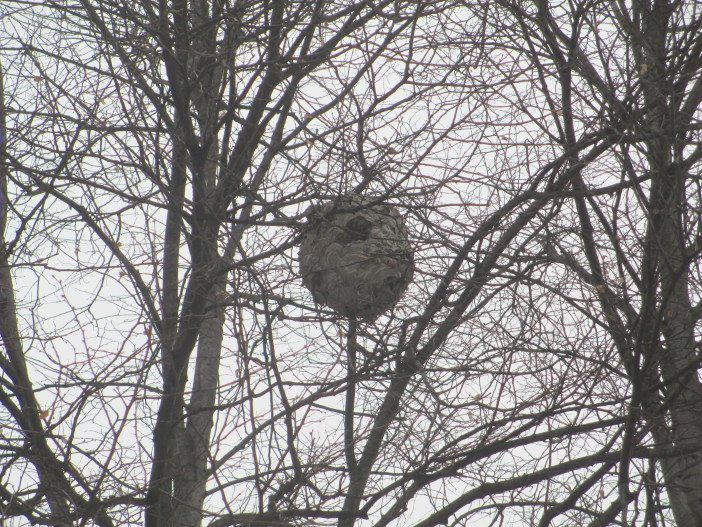
I went on a nest safari the very next day since it was a little warmer. I walked a little over a mile,zig-zagging from Beverley Road down to Brooklyn College, near where Flatbush and Nostrand cross. Not even going out of my way at all to cover extra ground, I spotted close to 20 – that’s a lot of nests! Think of how many more are out there on different routes! They’re everywhere if you’re actually looking for them, and with the snowfall still giving us its white backdrop, they’re even easier to spot.
Now, winter’s not my favorite season – I’ve always been a fan of the warmer months – but there is one thing that a naked tree can offer that a clothed one cannot: that unobstructed snapshot of what its denizens have been up to behind that great Oz curtain of summer foliage. I don’t know about anyone else, but I am always interested to see who built the most glorious nests that summer, be it birds, squirrels, or wasps. But the wasps’ nests are definitely capturing my attention this time around, because until I went on my wasp safari, I never realized just how extraordinarily abundant they are around here.
In case you were wondering, the bald-faced hornets are the architects responsible for these beautiful and singular tree decorations in our neighborhood. I captured this young lady last summer while she was chewing wood pulp for nest-building material.
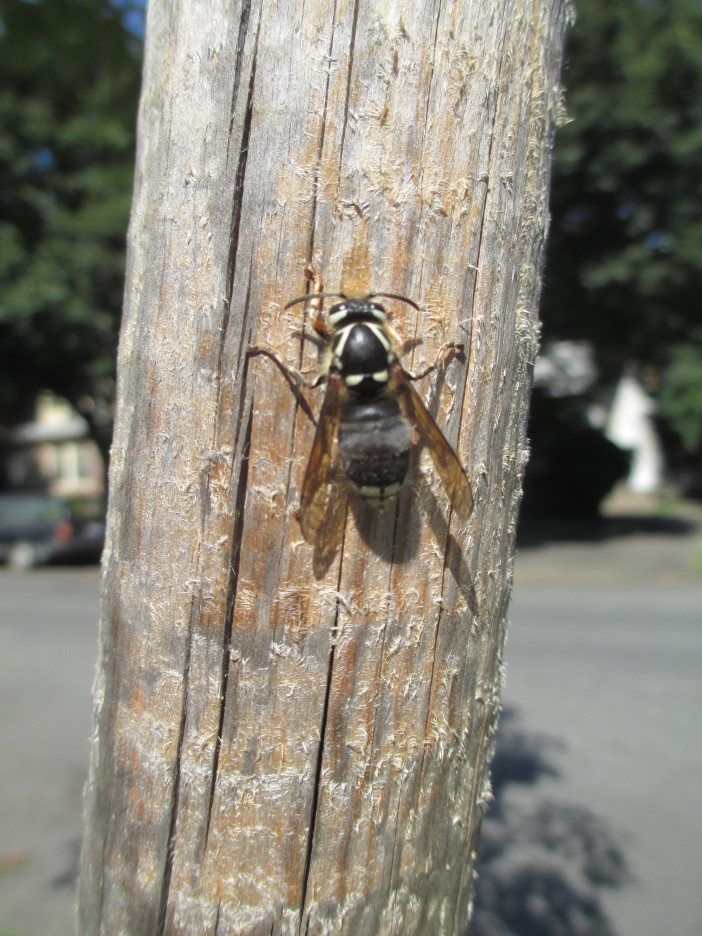
Their nests are usually about the size of a basketball or soccer ball, and the high ones can clearly be seen silhouetted against the sky after winter had defrocked our trees. Most of the nests I saw were between 10 and 30 feet high, but there were a few astronaut colonies that were waaay up there.
An interesting fact about bald-faced hornets is that they are actually not hornets at all. They’re a sub-species within a group of paper nest-building wasps known as yellow jackets. They earn the “bald-faced” label for having white-to-ivory coloration instead of yellow-toned ones like the other yellow jacket wasps.
Bald-faced hornets are kind of the Frank Lloyd Wrights in the wasp world, in that the form, shape and striated markings of their papered nests are quite singular, and not readily confused with other wasp species’ designs or engineering.
The nests are made from chewed-up wood pulp that they mix with their saliva to make wasp mortar. There are several tiers of combs inside where the young’uns are raised and the queen lays eggs as fast as a new cell is built. The outside is stuccoed with many smoothed layers of the wasps’ papier-mâché, with the entrance on the bottom, and small air vents on the top to keep it cool. It’s usually built around several converging twigs on a tree or bush for stability, but sometimes you can find their nests attached to man-made structures, like this transformer in my Uncle Pete’s backyard.
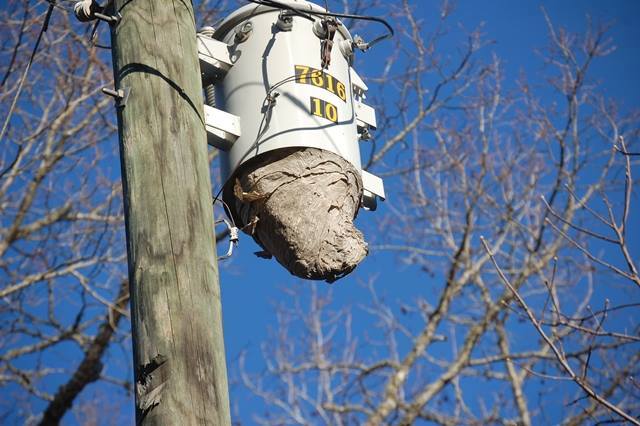
In winter, these dried-out pendulous nests are vacant real estate, inhabited only by the ghosts of dead hornets, and the occasional insect or spider squatters who are waiting out the winter. Every year a brand new queen will start a new nest, carrying within herself the biological means to create her own colony from scratch.
April and May is around when these shiny new queens will burrow out of the ground, or whatever tree or stump they wintered in. And when I say ‘shiny’, I do mean it – all the other wasps in these future nests will have tiny hairs all over them, but queens are completely hairless. Neat, huh? Last fall’s mating has given her plenty of ammo (she has sperm stored away to use as needed), and she’s ready to rock! There are eggs to lay and colonies to build!
After she’s emerged, a queen will find herself a worthy spot and begin her nest by chewing up some wood pulp and patting out a few paper cells attached to whatever foundation she has chosen. She’ll lay a single egg in each one, which takes six days to hatch into larvae, and then her busy work really begins. Like most wasps, our bald-faced hornets are carnivorous, and mom’s going to have to catch all manner of bugs and insects to chew up and feed her initial brood for the next few weeks (there’s no honey in a wasp nest).
It’s usually about three weeks from the initial egg-laying that the queen’s first generation of daughters are able to start bringing home the bacon themselves. The queen can now stay home, and it is up to her newly able workers to forage and build upon the nest, while she begins to populate her colony in earnest.
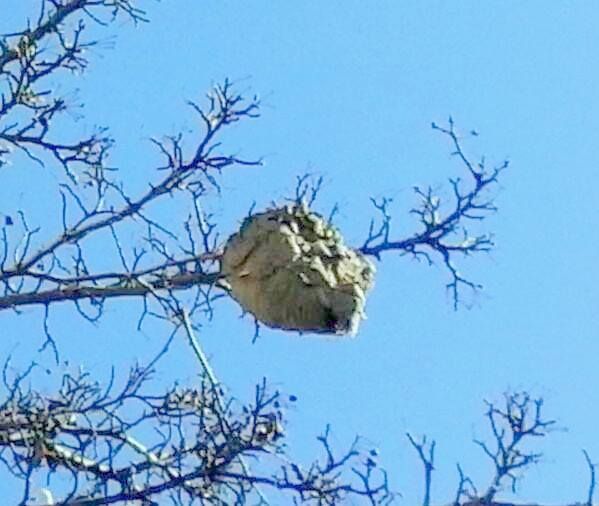
The bigger the nest is, the more eggs the queen can lay. More workers mean more food and resources, which means more larvae reach adulthood, which means more workers … you get the picture. From a single queen, a successful colony might reach anywhere from 400 to 700 members before the end of the season. That’s a lot of hornets, and let me say this just in case you don’t know: they ain’t playing. If you mess with them or get anywhere near their nest, you’d best have your boogie shoes on, because they will come after you. Bald-faced hornets and other wasps do not have barbed stingers, and a single wasp can – and will – sting you as many times as she thinks you deserve. They’re very protective of their nest and turf, so respect their space (or get a professional to remove them if they’ve set up base camp too close to your space).
There are very few predators that are brassy enough to try tackling a nest of hornets, and even fewer that live in the Ditmas Park area (perhaps that’s why our nests are so numerous around here?). Our city’s 24/7 All-You-Can-Eat Raccoon and Bird Buffet probably doesn’t help since it’s way easier to access, but I gotta say: I’d take that route, myself. Wasp larvae can’t be that yummy.
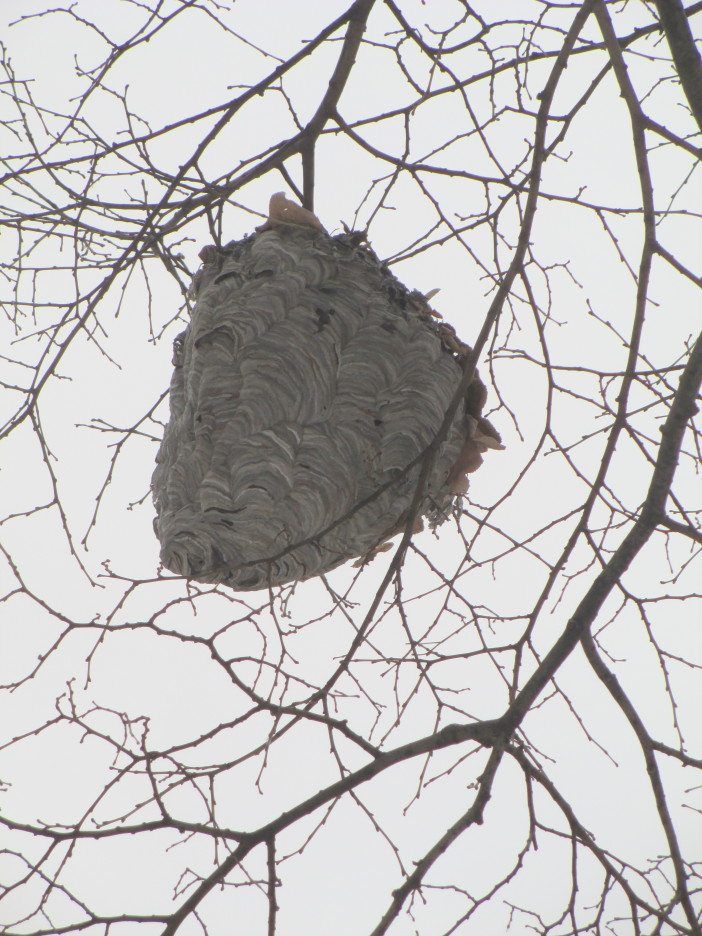
Toward fall, as they reach the end of colony-building season, the queen will lay a special set of eggs. Some of these eggs will become males, called drones, and others that are destined to be future queens. The matriarch has now reached the end of her reign and dies, leaving the rest of the colony to carry on her legacy.
When the new queens have successfully mated and captured the sperm from their chosen males, each will seek out her winter hidey-hole and will not emerge until the following spring when colony-building begins again, with all new players.
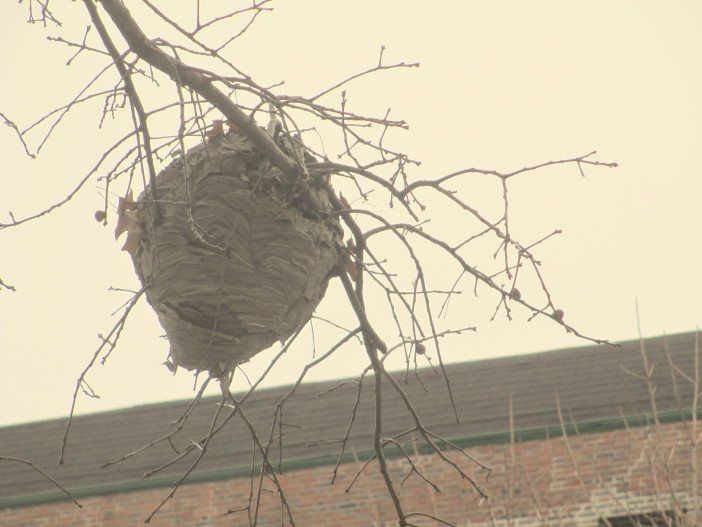
And guess what? After the first hard frost, the rest of the colony dies! A defrosted nest will not release a cloud of hornets because the queens are the only ones that have the fortitude to survive winter! MINE!
But then my uncle said they stink sometimes because of the dead broods inside…And I suppose they could let loose other critters and creepy-crawlies that hibernate in them…So I guess it’s still best to keep them outdoors, sigh.
Even so, it’s still pretty neat to look up and see all these cool little houses that have been hanging around like Chinese lanterns, waiting for us to notice them. I don’t know about you, but I certainly plan on taking more walks. I wonder what else I’ll discover while I’m looking up?




